Citroen JUMPY 2016 2.G Owner's Manual
Manufacturer: CITROEN, Model Year: 2016, Model line: JUMPY, Model: Citroen JUMPY 2016 2.GPages: 595, PDF Size: 12.47 MB
Page 201 of 595
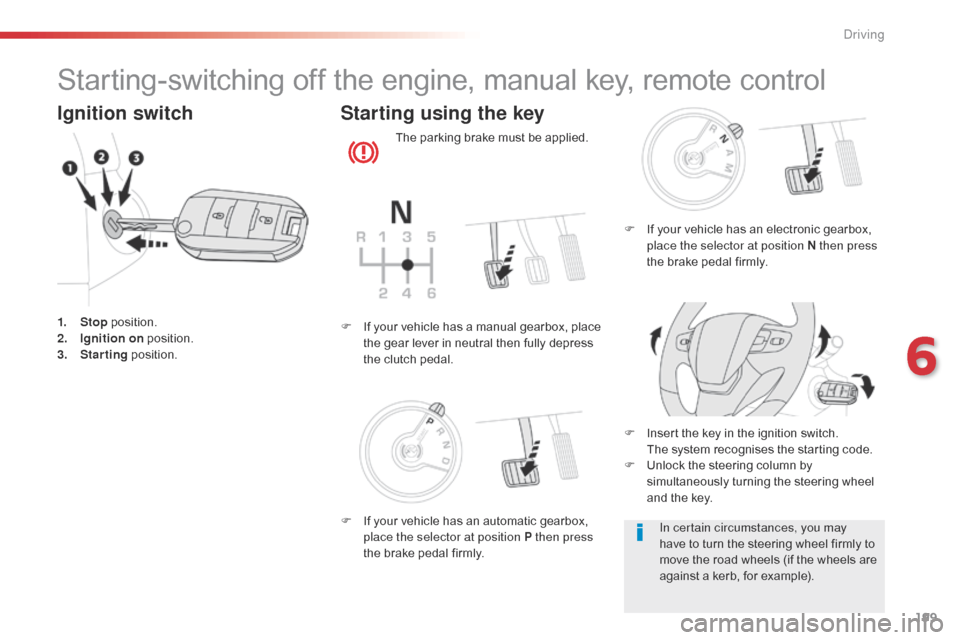
199
Jumpy _en_Chap06_conduite_ed01-2016
Starting-switching off the engine, manual key, remote control
Ignition switch
1. Stop position.
2. I gnition on position.
3.
S
tarting position.
Starting using the key
The parking brake must be applied.
F
I
nsert the key in the ignition switch.
T
he system recognises the starting code.
F
U
nlock the steering column by
simultaneously turning the steering wheel
and the key.
F
I
f your vehicle has a manual gearbox, place
the gear lever in neutral then fully depress
the clutch pedal.
In certain circumstances, you may
have to turn the steering wheel firmly to
move the road wheels (if the wheels are
against a kerb, for example).
F
I
f your vehicle has an electronic gearbox,
place the selector at position N then press
the brake pedal firmly.
F
I
f your vehicle has an automatic gearbox,
place the selector at position P then press
the brake pedal firmly.
6
Driving
Page 202 of 595

200
Jumpy _en_Chap06_conduite_ed01-2016
F Turn the key to position 2, ignition on, to
operate the engine pre-heating.
F
W
ait until this warning lamp
goes off in the instrument panel
then operate the starter motor
by turning the key to position 3
until the engine starts, without
pressing the accelerator. Once
the engine starts, release the key. The warning lamp does not come
on if the engine is already warm.
Depending on the climatic conditions,
it is recommended that you proceed as
follows:
-
I
n temperate conditions, do not
run the engine with the vehicle
stationary to warm it up, but rather
move off straight away and drive at
moderate engine speeds.
-
I
n wintry conditions, the pre-heater
warning lamp will stay on for a
longer period after switching on the
ignition; wait until it goes off before
starting.
-
In ver y severe wintr y
conditions
(
temperature
below
-23°C), to ensure the correct
operation and durability of the
mechanical components of your
vehicle (engine and gearbox), leave
the engine running for 4 minutes
before moving off.
Never leave the engine running in
an enclosed area without adequate
ventilation: internal combustion
engines emit toxic exhaust gases,
such as carbon monoxide. Danger of
intoxication and death. If the engine does not start straight
away, switch off the ignition.
Wait a few moments before trying
again. If the engine does not start after
a few attempts, do not keep trying: you
risk damaging the starter motor and the
engine.
Call on a CITROËN dealer or a qualified
workshop.
Driving
Page 203 of 595
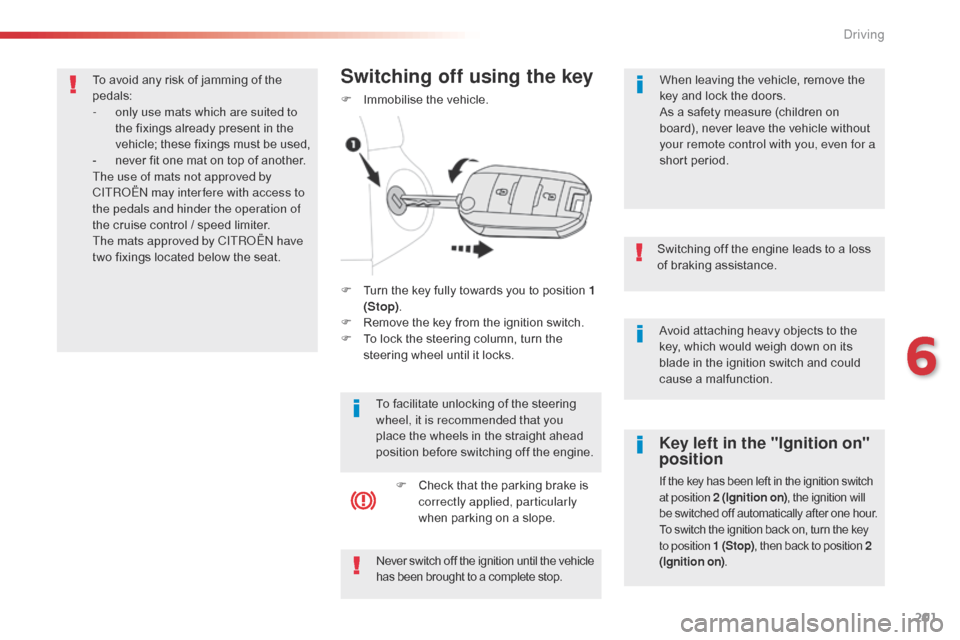
201
Jumpy _en_Chap06_conduite_ed01-2016
Avoid attaching heavy objects to the
key, which would weigh down on its
blade in the ignition switch and could
cause a malfunction.
Switching off the engine leads to a loss
of braking assistance.
Key left in the "Ignition on"
position
If the key has been left in the ignition switch
at position 2 (Ignition on)
, the ignition will
be switched off automatically after one hour.
To switch the ignition back on, turn the key
to position 1 (Stop) , then back to position 2
(Ignition on) .
Never switch off the ignition until the vehicle
has been brought to a complete stop.
F Turn the key fully towards you to position 1
(Stop) .
F
R
emove the key from the ignition switch.
F
T
o lock the steering column, turn the
steering wheel until it locks.
Switching off using the key
F Immobilise the vehicle.
To facilitate unlocking of the steering
wheel, it is recommended that you
place the wheels in the straight ahead
position before switching off the engine.F
C
heck that the parking brake is
correctly applied, particularly
when parking on a slope. When leaving the vehicle, remove the
key and lock the doors.
As a safety measure (children on
board), never leave the vehicle without
your remote control with you, even for a
short period.
To avoid any risk of jamming of the
pedals:
-
o
nly use mats which are suited to
the fixings already present in the
vehicle; these fixings must be used,
-
n
ever fit one mat on top of another.
The use of mats not approved by
CITROËN may inter fere with access to
the pedals and hinder the operation of
the cruise control / speed limiter.
The mats approved by CITROËN have
two fixings located below the seat.
6
Driving
Page 204 of 595
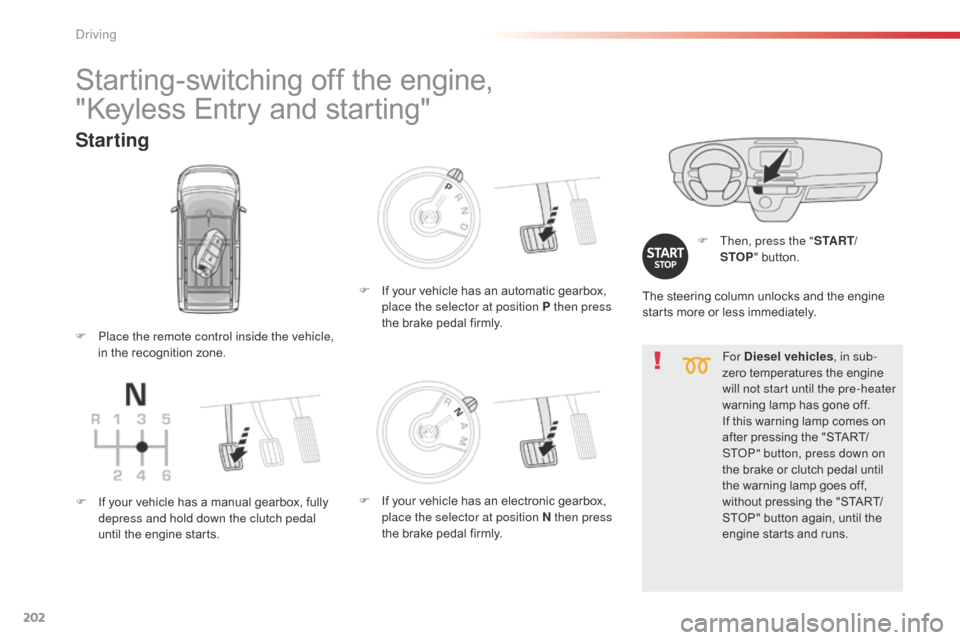
202
Jumpy _en_Chap06_conduite_ed01-2016
For Diesel vehicles, in sub-
zero temperatures the engine
will not start until the pre-heater
warning lamp has gone off.
If this warning lamp comes on
after pressing the "START/
STOP" button, press down on
the brake or clutch pedal until
the warning lamp goes off,
without pressing the "START/
STOP" button again, until the
engine starts and runs.
Starting
F Then, press the " S TA R T/
STOP " button.
Starting-switching off the engine,
"Keyless Entry and starting"
The steering column unlocks and the engine
starts more or less immediately.
F
P
lace the remote control inside the vehicle,
in the recognition zone.
F
I
f your vehicle has a manual gearbox, fully
depress and hold down the clutch pedal
until the engine starts. F
I
f your vehicle has an automatic gearbox,
place the selector at position P then press
the brake pedal firmly.
F
I
f your vehicle has an electronic gearbox,
place the selector at position N then press
the brake pedal firmly.
Driving
Page 205 of 595

203
Jumpy _en_Chap06_conduite_ed01-2016
The presence in the recognition zone of
the remote control of the "Keyless Entry
and Starting" system is essential.
Never leave the vehicle with the engine
running and with the remote control on
your person.
If the remote control leaves the
recognition zone, a message is
displayed.
Move the remote control into the zone
to be able to start the engine.If one of the starting conditions is
not met, a message appears in the
instrument panel screen. In some
circumstances, it is necessary to
turn the steering wheel slightly while
pressing the "START/STOP" button
to assist unlocking of the steering;
a message warns you when this is
needed. If the vehicle is not immobilised, the
engine will not stop.Switching off
F Immobilise the vehicle.
F
W
ith the remote control in
the recognition zone, press
the
"START/STOP " button.
The engine stops and the steering column is
locked.
Ignition on
(without starting)
With the ignition on, the system
automatically goes into energy
economy mode to maintain an adequate
state of charge in the battery. With the Keyless Entry and Starting
remote control inside the vehicle,
pressing the "START/STOP" button,
with no action on the pedals , allows the
ignition to be switched on.
This also allows the accessories to be used
(for
example: audio system, lighting...).
F
P
ress the "START/STOP" button,
the instrument panel comes on
but the engine does not start.
F
P
ress the button again to switch
off the ignition and allow the
vehicle to be locked.
To avoid any risk of jamming of the
pedals:
-
o
nly use mats which are suited to
the fixings already present in the
vehicle; these fixings must be used,
-
n
ever fit one mat on top of another.
The use of mats not approved by
CITROËN may inter fere with access to
the pedals and hinder the operation of
the cruise control / speed limiter.
The mats approved by CITROËN have
two fixings located below the seat.
6
Driving
Page 206 of 595
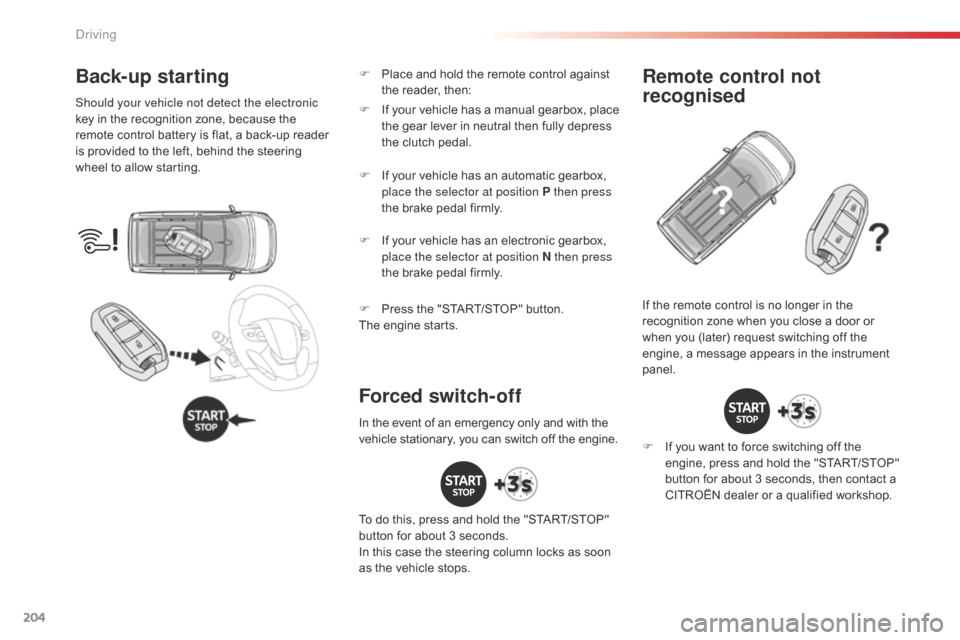
204
Jumpy _en_Chap06_conduite_ed01-2016
Back-up starting
Should your vehicle not detect the electronic
key in the recognition zone, because the
remote control battery is flat, a back-up reader
is provided to the left, behind the steering
wheel to allow starting.F
P
ress the "START/STOP" button.
The engine starts. If the remote control is no longer in the
recognition zone when you close a door or
when you (later) request switching off the
engine, a message appears in the instrument
panel.
Forced switch-offRemote control not
recognised
F If you want to force switching off the
engine, press and hold the "START/STOP"
button for about 3 seconds, then contact a
CITROËN dealer or a qualified workshop.
F
I
f your vehicle has a manual gearbox, place
the gear lever in neutral then fully depress
the clutch pedal.
F
I
f your vehicle has an automatic gearbox,
place the selector at position P then press
the brake pedal firmly.
F
I
f your vehicle has an electronic gearbox,
place the selector at position N then press
the brake pedal firmly.
In the event of an emergency only and with the
vehicle stationary, you can switch off the engine.
To do this, press and hold the "START/STOP"
button for about 3 seconds.
In this case the steering column locks as soon
as the vehicle stops. F
P
lace and hold the remote control against
the reader, then:
Driving
Page 207 of 595
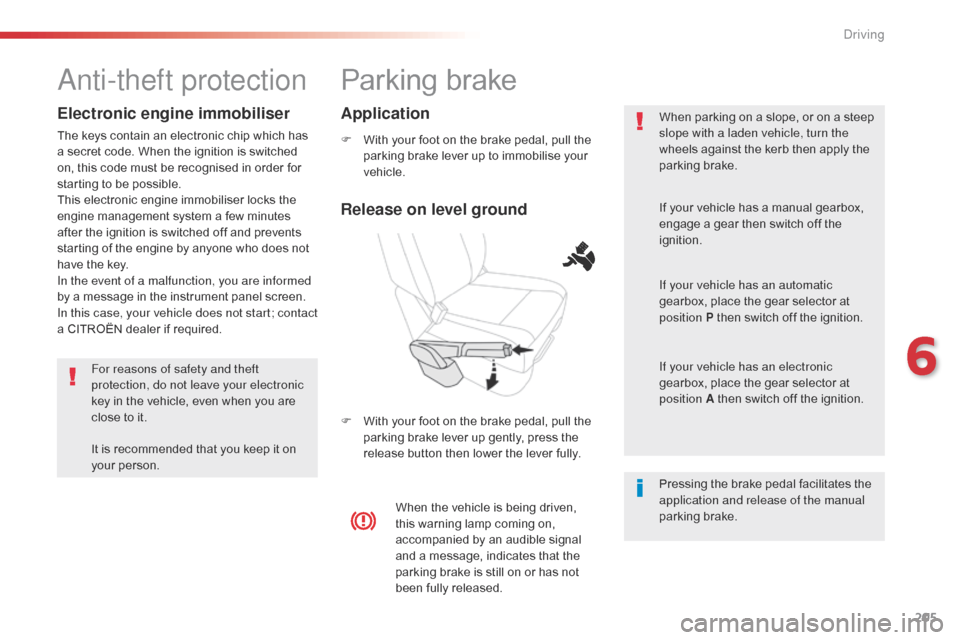
205
Jumpy _en_Chap06_conduite_ed01-2016
Parking brake
F With your foot on the brake pedal, pull the parking brake lever up to immobilise your
vehicle.
F
W
ith your foot on the brake pedal, pull the
parking brake lever up gently, press the
release button then lower the lever fully. When parking on a slope, or on a steep
slope with a laden vehicle, turn the
wheels against the kerb then apply the
parking brake.
When the vehicle is being driven,
this warning lamp coming on,
accompanied by an audible signal
and a message, indicates that the
parking brake is still on or has not
been fully released. Pressing the brake pedal facilitates the
application and release of the manual
parking brake. If your vehicle has a manual gearbox,
engage a gear then switch off the
ignition.
If your vehicle has an automatic
gearbox, place the gear selector at
position P then switch off the ignition.
If your vehicle has an electronic
gearbox, place the gear selector at
position A then switch off the ignition.
Release on level ground Application
Anti-theft protection
Electronic engine immobiliser
The keys contain an electronic chip which has
a secret code. When the ignition is switched
on, this code must be recognised in order for
starting to be possible.
This electronic engine immobiliser locks the
engine management system a few minutes
after the ignition is switched off and prevents
starting of the engine by anyone who does not
have the key.
In the event of a malfunction, you are informed
by a message in the instrument panel screen.
In this case, your vehicle does not start; contact
a CITROËN dealer if required.
For reasons of safety and theft
protection, do not leave your electronic
key in the vehicle, even when you are
close to it.
It is recommended that you keep it on
your person.
6
Driving
Page 208 of 595

206
Jumpy _en_Chap06_conduite_ed01-2016
Hill start assist
System which keeps your vehicle immobilised
temporarily (approximately 2 seconds) when
starting on a gradient, the time it takes to
move your foot from the brake pedal to the
accelerator pedal.
It only operates when:
-
t
he vehicle is completely stationary, with
your foot on the brake pedal,
-
t
he driver’s door is closed.
This hill start assist system cannot be
deactivated.
On a descending slope, with the vehicle
stationary and reverse gear engaged, the
vehicle is held momentarily when you
release the brake pedal.
On an ascending slope, with the vehicle
stationary, the vehicle is held for a momentarily
when you release the brake pedal.
Operating fault
F If your vehicle has a manual gearbox, place
the lever in the first gear position or in
neutral.
F
I
f your vehicle has an automatic gearbox,
place the selector at position D or select
manual operation M .
F
I
f your vehicle has an electronic gearbox,
place the selector at position A or M .If a fault in the system occurs, this warning
lamp comes on accompanied by a message.
Contact a CITROËN dealer or a qualified
workshop as soon as possible to have the
system checked.
Do not leave the vehicle while it is being
held in the hill start assist phase.
If you need to get out of the vehicle with
the engine running, apply the parking
brake manually then ensure that the
parking brake indicator lamp is on.
If your vehicle has an automatic
gearbox and you have to move off on
a steep slope (rising or falling) with a
loaded vehicle, press the brake pedal ,
select position D , release the parking
brake then release the brake pedal.
Driving
Page 209 of 595
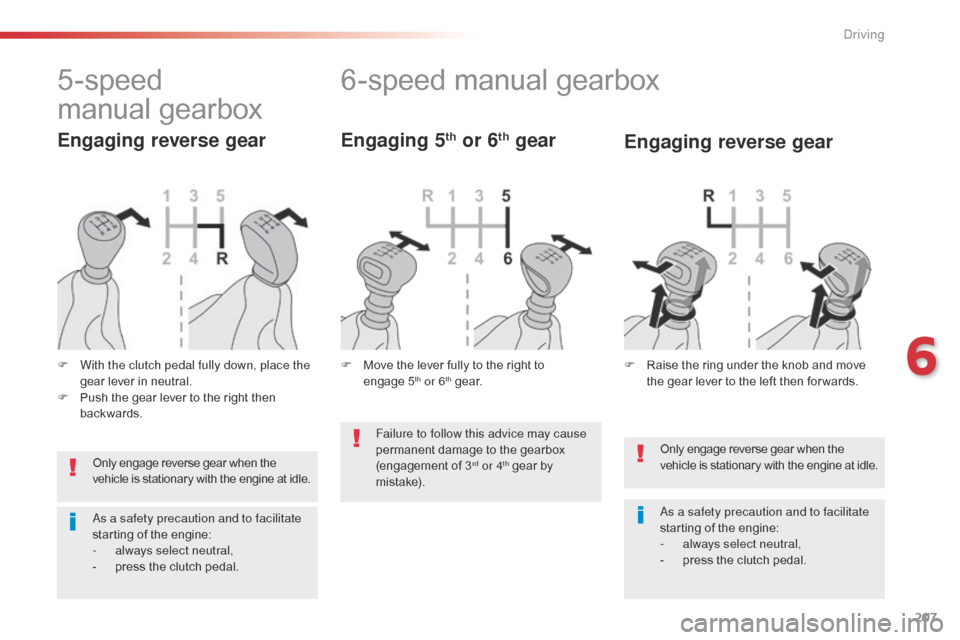
207
Jumpy _en_Chap06_conduite_ed01-2016
Only engage reverse gear when the
vehicle is stationary with the engine at idle.
As a safety precaution and to facilitate
starting of the engine:
-
a
lways select neutral,
-
p
ress the clutch pedal.
6-speed manual gearbox
Engaging 5th or 6th gear
Only engage reverse gear when the
vehicle is stationary with the engine at idle.
As a safety precaution and to facilitate
starting of the engine:
-
a
lways select neutral,
-
p
ress the clutch pedal.
5-speed
manual gearbox
F With the clutch pedal fully down, place the gear lever in neutral.
F
P
ush the gear lever to the right then
backwards.
Engaging reverse gear Engaging reverse gear
F Raise the ring under the knob and move
the gear lever to the left then for wards.
F
M
ove the lever fully to the right to
engage 5th or 6th g e a r.
Failure to follow this advice may cause
permanent damage to the gearbox
(engagement of 3
rd or 4th gear by
m i st a ke).
6
Driving
Page 210 of 595

208
Jumpy _en_Chap06_conduite_ed01-2016
Gear efficiency indicator
Depending on the driving situation and your
vehicle's equipment, the system may advise
you to skip one or more gears.
You can follow this instruction without going
through the intermediate gears.-
Y
ou press the accelerator pedal.
-
Y
ou are in third gear.-
T
he system may suggest that you engage
a higher gear.
The information appears in the instrument
panel in the form of an arrow.
On vehicles with manual gearbox, the arrow
may be accompanied by the recommended
g e a r.
The system adapts its gear change
recommendation according to the
driving conditions (gradient, load,
...)
and the demands of the driver (power,
acceleration, braking,
...).
The system never suggests:
-
e
ngaging first gear,
-
enga
ging reverse gear.
System which reduces fuel consumption by recommending the most suitable gear.
Example:
On certain BlueHDi Diesel versions
with manual gearbox, the system may
suggest changing into neutral
(N
is
displayed in the instrument panel) so
that the engine can go into standby
(STOP mode with Stop & Start), in
certain driving conditions.
This function cannot be deactivated. The gear engagement
recommendations must not be
considered compulsory.
This is because the configuration of
the road, traffic density and safety
remain impor tant factors in the
choice of the best gear.
The gear efficiency indicator system
does not replace the need for vigilance
on the part of the driver.
Driving